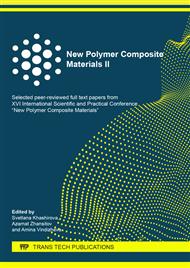[1]
T.J. Meyer, D.P. Jarrison, A.M. Lapides, et al., Coordination Chemistry of Single-Site Catalyst Precursors in Reductively Electropolymerized Vinylbipyridine Films, Inorg. Chem. 52 (2013) 4747-4749.
DOI: 10.1021/ic302472r
Google Scholar
[2]
H. Laguitton-Pasquier, A. Martre, A. Deronzier, Photophysical Properties of Soluble Polypyrrole-Polypyridyl-Ruthenium (II) Complexes, J. Phys. Chem. 105 (2001) 4801-4809.
DOI: 10.1021/jp002188e
Google Scholar
[3]
A.M.C. Assumpção, H.E. Toma, J.A. Bonacin, et al., Probing Surface-Complex Interactions with the bis(4-thienylterpyridine) iron (II) complex anchored on TiO2 and gold nanoparticles, Can. J. Chem. 92 (2014) 918-924.
DOI: 10.1139/cjc-2014-0025
Google Scholar
[4]
S.A. Moya, R. Pastene, H. Le Bozec, et al., Metallic carbonyl complexes containing heterocycles nitrogen ligands, Inorg. Chim. Acta. 312 (2001) 7-14.
DOI: 10.1016/s0020-1693(00)00292-9
Google Scholar
[5]
M.J. Clarke, Ruthenium metallopharmaceuticals, Coord. Chem. Rev. 232 (2002) 69-93.
Google Scholar
[6]
U.S. Schubert, C. H. Weidl, A. Cattani, et al., Metallo-supramolecular fullerene assemblies and polymers, Polym. Prepr. 41 (2000) 229-230.
Google Scholar
[7]
H. Hofmeier, U.S Schubert, Recent developments in the supramolecular chemistry of terpyridine-metal complexes, Chem. Soc. Rev. 33 (2004) 373-399.
DOI: 10.1039/b400653b
Google Scholar
[8]
G.I. Dzhardimalieva, I.E. Uflyand, Recent advances in the chemistry of metal chelate monomers, J. Coord. Chem. 70 (2017) 1468-1527.
DOI: 10.1080/00958972.2017.1317347
Google Scholar
[9]
I.E. Uflyand, G.I. Dzhardimalieva, B.C. Yadav, S. Singh, Self-healing and shape memory metallopolymers: state-of-the-art and future perspectives, Dalton Trans. 49 (2020) 3042-3087.
DOI: 10.1039/c9dt04360h
Google Scholar
[10]
N.P. Tzanetos, A.K. Andreopoulou, J.K. Kallitsis, Side-chain terpyridine polymers through atom transfer radical polymerization and their ruthenium complexes, J. Polym. Sci. Part A: Polym. Chem. 43 (2005) 4838-4848.
DOI: 10.1002/pola.20950
Google Scholar
[11]
B.G. Lohmeijer, U.S. Schubert, Playing LEGO with macromolecules: Design, synthesis, and self-organization with metal complexes, J. Polym. Sci. Part A: Polym. Chem. 41 (2003) 1413-1427.
DOI: 10.1002/pola.10685
Google Scholar
[12]
U.S. Schubert, M. Heller, Metallo-Supramolecular Initiators for the Preparation of Novel Functional Architectures, Chem. Eur. J. 7 (2001) 5252-5259.
DOI: 10.1002/1521-3765(20011217)7:24<5252::aid-chem5252>3.0.co;2-9
Google Scholar
[13]
K.T. Potts, D.A. Usifer, A. Guadalupe, H.D. Abruna, 4-Vinyl-, 6-Vinyl-, and 4'-Viny1-2,2':6',2''-terpyridinyl Ligands: Their Synthesis and the Electrochemistry of Their Transition-Metal Coordination Complexes, J. Am. Chem. Soc. 109 (1987) 3961-3967.
DOI: 10.1021/ja00247a021
Google Scholar
[14]
I.E. Uflyand, V.A. Zhinzhilo. G.I. Dzhardimalieva, Coordination Polymer Based on Nickel (II) Maleate and 4'‑Phenyl‑2,2':6',2"‑Terpyridine: Synthesis, Crystal Structure and Conjugated Thermolysis, J. Inorg. Organomet. Polym. 30 (2020) 965-975.
DOI: 10.1007/s10904-019-01227-8
Google Scholar
[15]
S. Bode, M. Enke, U.S. Schubert, and et.al., Correlation between scratch healing and rheological behavior for terpyridine complex based metallopolymers, J. Mater. Chem. A, 3 (2015) 22145-22153.
DOI: 10.1039/c5ta05545h
Google Scholar
[16]
A.D. Pomogailo, B.S. Savost'yanov, Metal-containing monomers and polymers on their basis, Khimiya, Moscow, (1988).
Google Scholar
[17]
H. Yamada, Y. Yamamoto, Ultraviolet excitation of Raman spectra of pyridines adsorbed on oxides, J. Chem. Soc., Faraday Trans. 75 (1979)1215-1221.
DOI: 10.1039/f19797501215
Google Scholar
[18]
S. Gorduk, H. Yilmaz, O. Andac, Cu (II) and Cd (II) coordination polymers derived from pyrazine-2,3-dicarboxylato and 1-vinylimidazole ligands: Synthesis, characterization and hydrogen storage capacities, Maced. J. Chem. Chem. Eng. 38 (2019) 19-27.
DOI: 10.20450/mjcce.2019.1711
Google Scholar
[19]
H.V. Poel, G.V. Koten, K. Vrieze, Novel bonding modes of α-diimines. Synthesis and characterization of [MCl2L(α-diimine)] and [MCl2(α-diimine)n] (M = Pd, Pt; L = phosphine, arsine; n = 1, 2) containing σ,σ-N,N', σ-N, or σ-N↔σ-N' bonded α-diimines, Inorg. Chem. 19 (1980) 1145-1151.
DOI: 10.1021/ic50207a008
Google Scholar
[20]
N.P. Porolo, A.D. Pomogailo, I.E. Uflyand, et.al., Synthesis and reactivity of metal-containing monomers. Synthesis and structure of salts of unsaturated dicarboxylic acids, Russ. Chem. Bull. 46 (1997) 362-370.
DOI: 10.1007/bf02494382
Google Scholar
[21]
G.B. Deacon, R.J. Phillips, Relationships between the carbon-oxygen stretching frequencies of carboxylato complexes and the type of carboxylate coordination, Coord. Chem. Rev. 33 (1980) 227-250.
DOI: 10.1016/s0010-8545(00)80455-5
Google Scholar
[22]
R.K. Baimuratova, G.I. Dzhardimalieva, N.D. Golubeva, N.N. Dremova, A.V. Ivanov, Coordination polymers based on trans, trans-muconic acid: synthesis, structure, adsorption and thermal properties, Pure Appl. Chem. (2019) https://doi.org/10.1515/pac-2019-1108.
DOI: 10.1515/pac-2019-1108
Google Scholar


